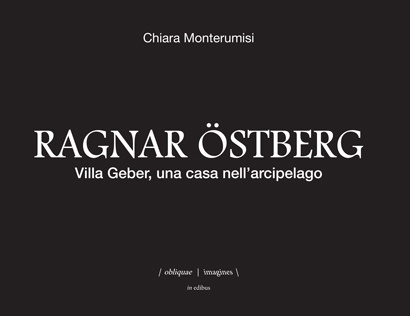
Östberg and the legacy of the much wider ‘Norden’
The book of Chiara Monterumisi comes to fill this gap, offering us a comprehensive overview of Östberg; the only book after the one of the architectural historian Elias Cornell (1965) dedicated to the award-winning (Gold Medal from the RIBA in 1926 and from the American Institute of Architects in 1932) and founder of the Swedish national romanticism. Choosing the less known, but much admired Villa Geber (1911-1913) as counterpoint to the monumental masterpiece of Östberg, Monterumisi introduces us implicitly into the overall production and the personality of the architect. The book starts with an investigation and a broad contextualization of the national romantic movement and its forefather, followed by an analysis of the Nordic conception of dwelling and of the concept of “home” and “native land” and culminates with the compositional analysis of Villa Geber, a unique example of courtyard house in the Nordic panorama2 and the discovery of its inner «petrified garden»3.
Villa Geber, a house in the archipelago, as the subtitle reads, occupies only one third of the whole volume. The reason of such structure of the book and of its narration through gradual narrow-down themes lies in the author’s will to provide us with «the suitable keys for interpreting and understanding»4 Östberg production and Villa Geber as «a house in the form of a city»5.
As the Town Hall is recalling the Palazzo Ducale in many aspects, similarly Villa Geber presents considerable analogies with the Venetian palaces. [...] Östberg interpreted simultaneously – and almost picturesquely – the features of the Italian villas with rural and medieval traditions, succeeding in expressing the new spirit of the villa situated in the suburban plan»6. So, writes Cornell in 1965. Monterumisi goes beyond Cornell’s «superficial analogies»7 between Stockholm and Venice, offering a morphological and typological, comparative analysis between the two countries/cities, highlighting the ability of Östberg to overcome the mere academic historicism (widespread at that time) and to interpret the typology of the patio house – of Mediterranean origins – in order to tailor it to the needs and sensibilities, both contextual and “mythological” of the Norden, through a conflation of elements which «display a wide dependence on the architecture of the past and a magnificent traditional execution […] that people were convinced that there was no reclaim of the past»8.
This is the convincing lesson, still valid today, that Östberg offers and the book of Monterumisi skillfully highlights, identifying topics and forms shared between Villa Geber and the Stockholm Town Hall; such as for example, the asymmetrical syntax which arranges the overall layout keeping a «high degree of impressiveness and dignity»9; or the courtyard form as center and curtain wall, a tool useful for the spatial and social arrangement of both residential and public buildings.
The study of the past, the reinterpretation of the local tradition and of the genius loci and the focus on the fact that the «art of construction should not become an exclusive mechanical practice having as unique target utility»10 as Östberg wrote in 1928, are the key elements driving the choices of the Nordic architects-town planners of the first quarter of the 20th century – that really fascinated their Italian colleagues (Persico, Pagano, Muratori and others as highlighted in the book) – and remain of great relevance even today.
Heleni Porfyriou
Note
1 E. Cornell, Ragnar Östberg Svensk arkitekt, Byggmästaren Förlag, Stockholm,1965, p. 312 Cfr. C. Monterumisi, Ragnar Östberg. Villa Geber una casa nell’arcipelago, Obliquae Imagines in Edibus, Vicenza, 2017, p. 126.
3 Ibidem, p. 23.
4 Ibidem, p. 23.
5 Ibidem, p. 87.
6 E. Cornell, cit., p. 174.
7 C. Monterumisi, cit., p. 129.
8 Ibidem, p. 19.
9 Ibidem, p. 113.
10 Östberg R., Ny riktlinje, in En arkitekt anteckningar. Bilder och verk av författaren, Bokförlaget Natur och Kultur, Stockholm, 1928, p. 167.
Preface: Luca Ortelli
Title: Ragnar Östberg
Subtitle: Villa Geber una casa nell’arcipelago
Language: Italian (with summaries in English and Swedish)
Publisher: Obliquae Imagines in Edibus
Characteristic: 21x27 horizontal, 180 pages, paperback, colors
ISBN: 978-88-97221-51-7
Year: luglio 2017
